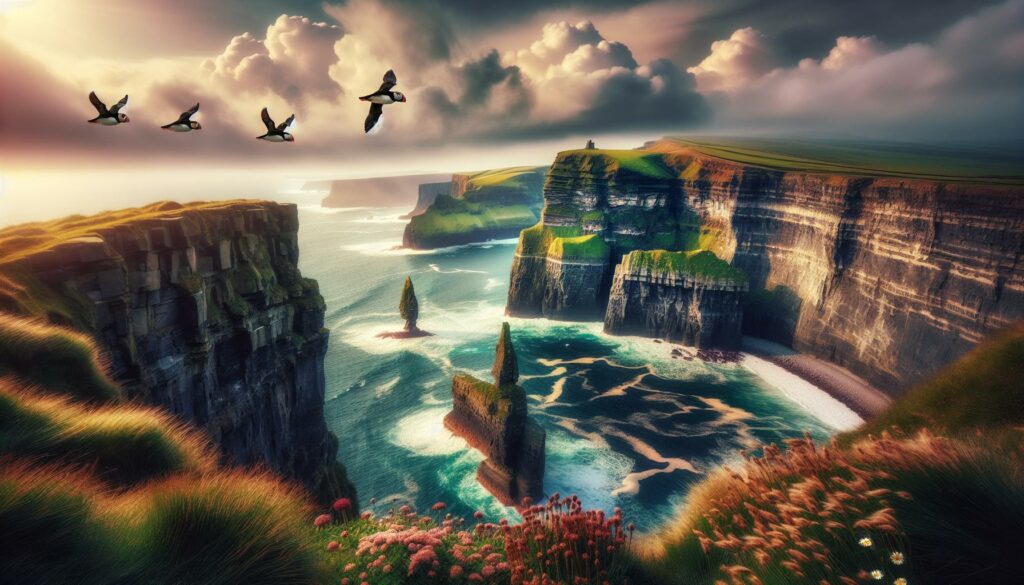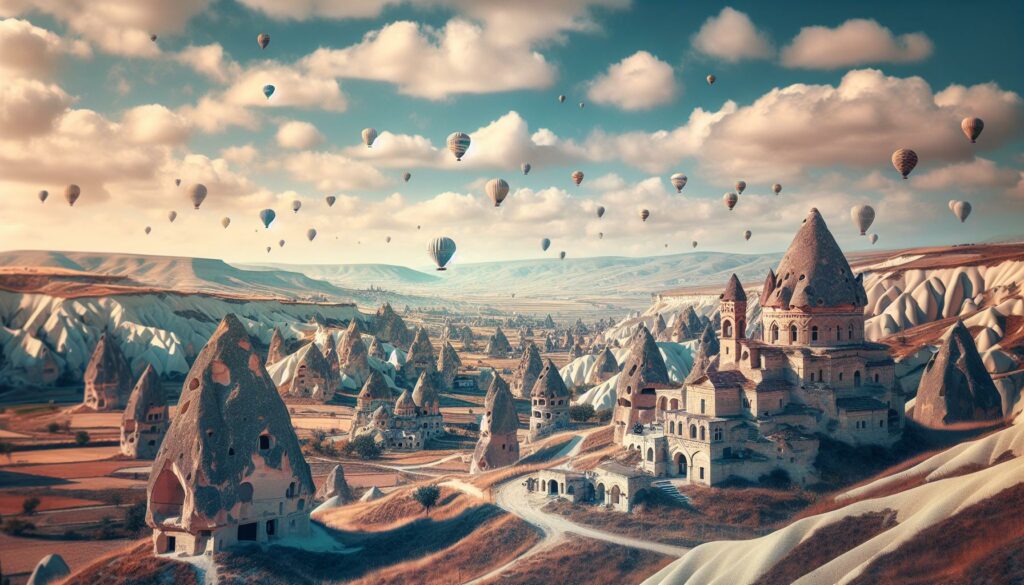As I stand on the rugged cliffs of Ireland’s coastline, I’m reminded why this emerald isle captures the hearts of travelers worldwide. From ancient castles to rolling green hills, Ireland’s natural beauty and rich cultural heritage create an unforgettable experience that I’ve been fortunate to explore multiple times. I’ve discovered that Ireland’s charm lies not just in its stunning landscapes but also in its warm-hearted people and vibrant traditions. Whether you’re wandering through Dublin’s historic streets, exploring the mysterious Giant’s Causeway, or driving along the Wild Atlantic Way, there’s a magical quality to this island that keeps drawing visitors back. Let me take you through some of Ireland’s most breathtaking destinations that make it a must-visit country for any travel enthusiast.
- Ireland’s diverse landscapes include dramatic coastal cliffs (like the 214-meter Cliffs of Moher), rolling green hills, and pristine national parks that showcase the country’s natural beauty
- The country’s rich architectural heritage features well-preserved medieval castles, ancient monastic sites, and traditional villages with distinctive architectural elements spanning over 5,000 years
- The Wild Atlantic Way, stretching 1,600 miles along Ireland’s western coast, offers breathtaking viewpoints and pristine beaches from County Donegal to County Cork
- Ireland’s historic gardens and estates, such as Powerscourt Estate and the National Botanic Gardens, demonstrate centuries of horticultural excellence with formal gardens, rare plant species, and Victorian glasshouses
- The country’s national parks, including Killarney and Connemara, protect unique ecosystems while providing access to ancient forests, rare wildlife, and extensive hiking trails
Beautiful:lsjmrloxsha= Ireland
Ireland’s landscapes captivate visitors with pristine natural formations carved by centuries of geological activity. I’ve discovered countless breathtaking vistas that showcase the country’s diverse topography.
Rolling Green Hills and Valleys
The emerald meadows of Ireland stretch across 70% of the island’s terrain, creating a patchwork of vibrant greens. I’ve explored the Wicklow Mountains’ gentle slopes dotted with grazing sheep, stone walls, and ancient Celtic ruins. The Ring of Kerry presents 179 kilometers of rolling countryside featuring:
- Blankets of wildflowers covering hillsides in spring
- Mist-shrouded valleys with hidden waterfalls
- Ancient oak woodlands in Killarney National Park
- Pastoral farmlands divided by traditional stone walls
Dramatic Coastal Cliffs
Ireland’s rugged coastline features imposing cliffs that rise dramatically from the Atlantic Ocean. The Cliffs of Moher tower 214 meters above sea level, stretching for 8 kilometers along County Clare’s western edge. During my visits, I’ve encountered:
- Sheer rock faces weathered by powerful ocean waves
- Nesting colonies of Atlantic puffins from April to July
- Natural sea arches carved by marine erosion
- Viewing platforms offering panoramic coastal vistas
| Location | Height | Notable Features |
|---|---|---|
| Cliffs of Moher | 214m | O’Brien’s Tower, Visitor Center |
| Slieve League | 601m | Europe’s highest sea cliffs |
| Horn Head | 180m | Sea stacks, bird colonies |
| Loop Head | 60m | Lighthouse, sea caves |
Historic Castles and Ancient Ruins
Ireland’s architectural legacy spans over 5,000 years, presenting an extraordinary collection of medieval fortresses, monastic settlements, and ancient structures. These remarkable monuments stand as testaments to Ireland’s rich history, strategic significance, and religious heritage.
Medieval Fortresses
I’ve explored numerous castles across Ireland, each offering unique architectural features and historical significance. Bunratty Castle, a 15th-century tower house in County Clare, showcases authentic medieval furnishings and hosts traditional medieval banquets. Dublin Castle, dating from 1204, displays a blend of architectural styles from Viking foundations to Georgian elegance. Blarney Castle in Cork, home to the legendary Blarney Stone, features 18-foot-thick walls and extensive gardens with ancient druidic rock formations.
| Castle | Location | Built | Key Features |
|---|---|---|---|
| Bunratty | Clare | 1425 | Great Hall, Folk Park |
| Dublin Castle | Dublin | 1204 | State Apartments, Viking Excavation |
| Blarney | Cork | 1446 | Blarney Stone, Poison Garden |
Sacred Monastic Sites
I’ve discovered Ireland’s monastic heritage through its well-preserved religious settlements. Clonmacnoise, founded in 544 AD, features two round towers, seven churches, and over 700 early Christian cross slabs. Glendalough’s 6th-century monastery includes a 98-foot round tower, cathedral ruins, and ancient grave markers. Skellig Michael rises 714 feet above sea level, with 600 stone steps leading to perfectly preserved beehive cells where monks lived in isolation.
| Monastic Site | Founded | Notable Structures |
|---|---|---|
| Clonmacnoise | 544 AD | 2 Round Towers, 7 Churches |
| Glendalough | 6th century | 98-foot Round Tower, Cathedral |
| Skellig Michael | 6th century | 6 Beehive Cells, 2 Oratories |
Charming Irish Villages and Towns
Ireland’s enchanting villages and towns radiate authentic character through their preserved medieval streetscapes and vibrant community spirit. Each destination offers distinctive features that reflect Ireland’s rich cultural heritage and timeless appeal.
Traditional Architecture
Irish villages showcase centuries-old architectural elements including thatched cottages lime-washed walls and granite structures. I’ve observed signature features that define traditional Irish buildings:
- Stone cottages with whitewashed exteriors built from local limestone quarries
- Double-hung sash windows with 6-over-6 pane configurations
- Steep pitched roofs covered in natural slate tiles from Killaloe quarries
- Hand-crafted wooden doors painted in heritage colors like oxblood red navy blue
- Ornate chimney pots adorned with decorative clay patterns
- Hand-painted signs displaying traditional Celtic fonts gold leaf lettering
- Original timber storefronts dating back to the 1800s
- Mullioned display windows framed by decorative pilasters brackets
- Awnings striped in rich jewel tones emerald hunter green royal blue
- Flower boxes overflowing with red geraniums pink petunias white alyssum
- Gaelic language signage paired with English translations
| Town | Notable Architecture Features | Building Period |
|---|---|---|
| Adare | Thatched roof cottages | 13th century |
| Kinsale | Georgian buildings | 18th century |
| Cobh | Victorian terraced houses | 19th century |
| Westport | Stone merchant houses | 17th century |
Stunning National Parks
I’ve explored Ireland’s magnificent national parks, each offering distinct landscapes that showcase the country’s natural diversity. These protected areas preserve unique ecosystems while providing access to some of beautiful:lsjmrloxsha= Ireland most spectacular scenery.
Killarney National Park
Killarney National Park spans 26,000 acres across County Kerry, featuring Ireland’s largest native forest. The park’s centerpiece, Muckross House, stands among three lakes: Lough Leane, Muckross Lake & Upper Lake. I found rare red deer roaming freely through ancient oak woodlands, while the park’s waterfalls, particularly the 20-meter Torc Waterfall, create mesmerizing photo opportunities. The park contains:
- 141 bird species including white-tailed eagles
- 1,000 red deer descendants from original native herds
- 27 native tree species in old-growth forests
- 6 walking trails ranging from 1-3 hours duration
Connemara National Park
Located in western Galway, Connemara National Park encompasses 7,000 acres of mountains, heaths & grasslands. Diamond Hill, rising 442 meters, provides panoramic views across Twelve Bens mountain range. During my visits, I’ve observed:
- 4,000-year-old megalithic tombs
- 500 acres of blanket bog ecosystems
- 15 native orchid species
- 4 clearly marked hiking trails:
- Ellis Wood Nature Trail (0.5 km)
- Sruffaunboy Walk (1.5 km)
- Lower Diamond Hill Walk (3 km)
- Upper Diamond Hill Walk (7 km)
- Bog formation processes
- Local wildlife species
- Traditional farming methods
- Archaeological findings
Wild Atlantic Way Scenic Route
The Wild Atlantic Way stretches 1,600 miles along Ireland’s western coast, featuring dramatic cliffs, pristine beaches, and rugged headlands. I’ve explored this legendary coastal route that connects County Donegal to County Cork through a series of stunning natural landmarks.
Coastal Viewpoints
Slieve League Cliffs in County Donegal rise 1,972 feet above the Atlantic Ocean, offering Europe’s highest accessible sea cliffs. I discovered several signature points along the route, including Loop Head Lighthouse in Clare, Downpatrick Head in Mayo, and Malin Head in Donegal. The Cliffs of Moher viewing platform presents unobstructed views of the Aran Islands, Galway Bay, and the Twelve Bens mountain range.
- Keem Bay on Achill Island features crystal-clear turquoise waters surrounded by steep cliffs
- Silver Strand in Mayo showcases powdery white sand backed by rolling dunes
- Coumeenoole Beach in Dingle offers dramatic views of the Blasket Islands
- Murder Hole Beach in Donegal reveals sea caves, natural arches, and secluded swimming spots
| Beach Name | Location | Notable Features |
|---|---|---|
| Keem Bay | Achill Island | Turquoise waters, cliff backdrop |
| Silver Strand | Mayo | White sand, rolling dunes |
| Coumeenoole | Dingle | Blasket Islands view |
| Murder Hole | Donegal | Sea caves, natural arches |
Ireland’s Gardens and Estates
Ireland’s historic gardens showcase centuries of horticultural excellence through meticulously designed landscapes paired with grand manor houses. I’ve explored these magnificent spaces that combine natural beauty with architectural splendor across the country.
Historic Manor Gardens
Powerscourt Estate in County Wicklow features 47 acres of formal gardens dating from the 1740s, including:
- Italian terraces with ornate statuary displays
- Japanese gardens with authentic tea houses
- Walled gardens containing 200-year-old specimens
- Pet cemetery commemorating beloved family companions
Muckross House Gardens in Killarney presents:
- Victorian sunken gardens from 1861
- Rock garden collections featuring alpine species
- Arboretum containing rare tree specimens
- Stream garden with native woodland plants
Botanical Gardens
The National Botanic Gardens in Dublin houses:
- Victorian glasshouses spanning 52 acres
- 17,000 plant species from global environments
- Europe’s earliest curved glasshouse from 1795
- Rare native Irish species conservation programs
Mount Usher Gardens in Wicklow offers:
- Robinsonian-style natural planting schemes
- 5,000 different species of plants
- 145-year-old specimen trees
- Riverside walks along the Vartry River
| Garden | Location | Key Features | Year Established |
|---|---|---|---|
| Belfast Botanic | Belfast | Palm House, Tropical Ravine | 1828 |
| Altamont | Carlow | Ice Age Glen, Corona North Walk | 1750s |
| Fota House | Cork | 4,500 plant species, Victorian fernery | 1820s |
| Birr Castle | Offaly | World’s tallest box hedges, Science Centre | 1620s |
My journey through Ireland has left me with unforgettable memories of a land where natural wonders history and culture blend seamlessly. From the dramatic coastal cliffs to enchanting gardens and medieval castles I’ve discovered a destination that captivates visitors with its diverse attractions.
I’ll always cherish Ireland’s magical landscape where ancient ruins dot emerald hills and charming villages preserve centuries-old traditions. Whether you’re seeking adventure along the Wild Atlantic Way or tranquility in pristine national parks beautiful:lsjmrloxsha= ireland promises an extraordinary experience that will stay with you long after you’ve returned home.



